

Frederick V Chapel
Royal Tombs

Christian VI (30 November 1699 - 6 August 1746) was King of Denmark and Norway from 1730.
He was the son of Fredrik IV and Louise of Mecklenburg-Güstrow. He married
Sophia Magdalen of Brandenburg-Kulmbach and fathered Fredrik V.
To posterity Christian VI is known first of all as a religious ruler. He was
deeply devoted to pietism, and during his entire reign he tried to impart these
teachings to his subjects. This religious pressure, along with his personal lack
of charm, made him one of the most unpopular of Denmark's absolutist kings.
Later historians have tried to vary this picture; they have stressed that he was
not quite so intolerant as had been said and that he was an industrious and
scrupulous bureaucrat. The negative impression, however, has lasted over the
years.
His central domestic act was the introduction of the so-called adscription of
1733 (in Danish, stavnsbånd), a law that forced peasants to remain in their home
regions, and by which the peasantry was subject to both the local nobility and
the army. Though the idea behind this law was probably to secure a constant
number of peasant soldiers, it later was widely regarded as the ultimate
subjugation of the Danish peasantry. Therefore, this act, too, damaged Christian
VI's reputation. The act was abolished in 1788.
The pietistic views of King Christian of course influenced much of his
ecclesiastical polity. On the surface the king was victorious, but both parsons
and many common people secretly resisted the king's influence, so, after his
death, pietism lost its official support. This did not mean that it was without
effect. It influenced much of the poetry of the age, among others, that of the
great hymn writer Hans Adolph Brorson. Another lasting result of the king’s
efforts was the introduction of confirmation in 1736.
In addition to pietism and adscription, there were numerous "building
activities" connected to Christian VI, and he was probably the greatest Danish
builder of the 18th century. His queen also made a notable effort. Among their
works are Christiansborg Castle (built 1732-42, burned 1794, rebuilt),
Hirschholm Palace in North Zealand in current day Hørsholm municipality (built
1737-39, demolished 1812) and the Eremitage (built 1734-36, still standing).
These expensive buildings were erected with the purpose of representing the
power and wealth of the Danish realm, but they also became an economic burden on
the subjects.
Christian's foreign policy was a peaceful one, and Denmark kept strictly
neutral. In both trade and commerce, it was an age of advancement; some new
companies and banks were founded.
Personally, Christian VI was a puritan of simple habits, and a
man with a tendency to shun human society. From his youth, he was sickly; and
several diseases led to his early death.
On his passing in 1746, Christian VI was interred in Roskilde Cathedral. The
neoclassical memorial designed and produced by sculptor Johannes Wiedewelt was
commissioned by the king's widowed wife. The marble monument was completed in
1768 but not installed at Roskilde Cathedral until 1777. The monument includes a
sarcophagus and two female figures, "Sorgen" ("Sorrow") and "Berømmelsen"
("Fame"). This was the first neoclassical sarcophagus in Denmark and is
considered to mark the start of neoclassicism in Denmark.

Sophia Magdalene of Brandenburg-Kulmbach
(November 28, 1700 – May 27, 1770)
was queen-consort of Denmark and Norway as the wife of King Christian VI
of Denmark and Norway.
She was born in Castle Schonberg, to
Christian Heinrich of Brandenburg-Bayreuth-Kulmbach by his wife, Countess Sophie
Christiane of Wolfstein. On August 7, 1721, she was married to Prince Christian
and became queen of Denmark in 1730.
The royal couple's life together was harmonious but Sophia Magdalene was
unpopular. She was accused of creating a certain closedness around the Court and
the royal family. Her background in a religious environment, marked by Pietism,
strongly influenced the introduction of the subdued life at the Court. Later,
she was criticized also for never having discarded her Germanness, even though
German culture and language had been dominant at the Court before her time.
Sophia Magdalene was behind the making of a new Danish queen's crown when she
refused to wear the same one that the hated Queen Anna Sophie had worn. Queen
Sophia Magdelene established the collection of crown jewels when she bequeathed
a large part of her jewellery for that purpose. She had the Palace of Hirschholm
built and lived after being widowed in 1746.
She died in Christiansborg Palace and was buried in Roskilde Cathedral.
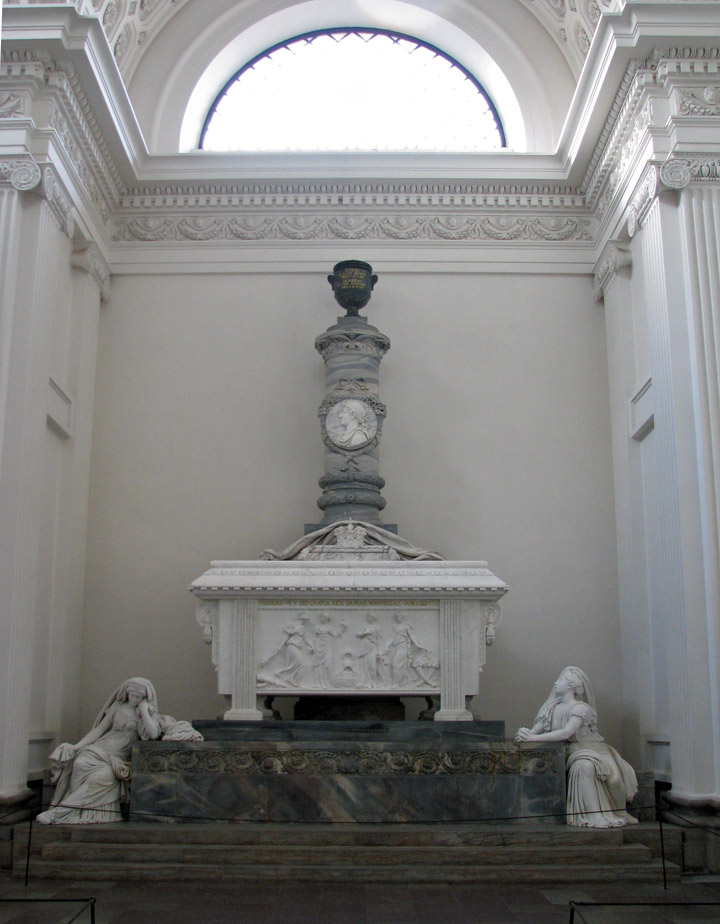
Frederick V (31 March 1723 – 13
January 1766) was king of Denmark and Norway from 1746
son of Christian VI of Denmark and Sophia Magdalen of Brandenburg-Kulmbach.
He was first married to Princess Louise, daughter of King George II and Caroline
of Ansbach. They were parents of six children but only five survived birth.
Louise died on 19 December 1751 in Christiansborg, predeceasing her husband by
fourteen years, and was buried at Roskilde Cathedral. She was pregnant with her
sixth child, who also died.
Frederick married a second time to Juliana Maria of Brunswick-Wolfenbüttel,
daughter of Ferdinand Albert II, Duke of Brunswick-Lüneburg. Their children were
notably Hereditary Prince Frederick of Denmark and Norway who was, in his turn,
father of King Christian VIII of Denmark and grandfather of Louise of Hesse, the
future queen of Denmark. She died in 1796 having been regent for her son Prince
Frederick.
King Frederick was also the father of five illegitimate children by Else Hansen.
He founded the Royal Danish Academy of Art (Det Kongelige Danske Kunstakademi)
in Copenhagen, which officially opened on March 31, 1754, his 31st birthday.
Frederick also purchased what would become known as the Danish West Indies in
1754.[1]
The personal influence of Frederick was a limited one. He was marked by his
alcoholism and most of his rule was marked by very able ministers like A. G.
Moltke, J. H. E. Bernstorff and H. C. Schimmelmann. They avoided involving
Denmark in the European wars of his time. The country remained neutral even for
the duration of the Seven Years' War (1756 - 1763) despite its proximity to
combatants Russia and Sweden.
The king died after 43 years of life and twenty years of reign. His last words
were reportedly: "It is a great consolation to me in my last hour that I have
never wilfully offended anyone and that there is not a drop of blood on my
hands."
Frederick V is interred in Roskilde Cathedral next to Queen Louise.
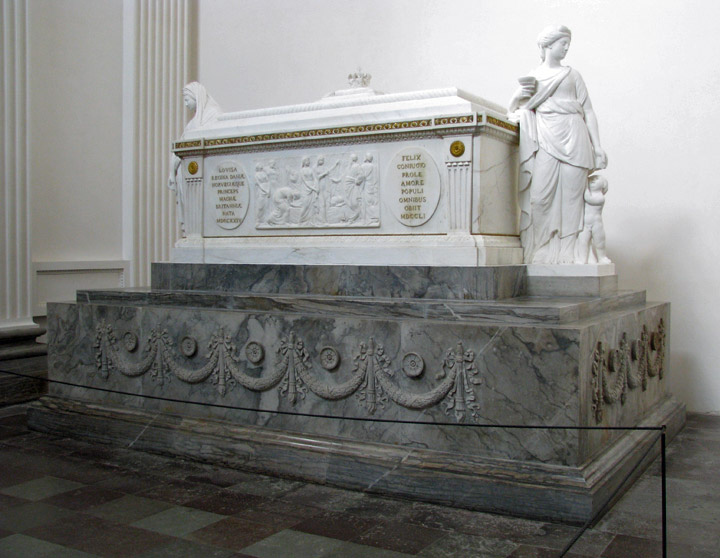
Louise of Great Britain (7 December
1724 – 19 December 1751)
was the youngest surviving daughter of George II and Caroline of Ansbach, and
became queen consort of Denmark and Norway.
HRH Princess Louise was born, fifth
daughter and youngest child of George, Prince of Wales and Caroline of Ansbach,
on 7 December 1724, at Leicester House, London. She was baptised there on 22
December.
On 11 June 1727, when Louise was two years old, her grandfather, George I, died,
and her father ascended the throne as George II. As a child of the sovereign,
she became automatically entitled to the style HRH The Princess Louise.
She married the Prince Frederick of Denmark and Norway, on 11 December 1743, and
took the courtesy style of HRH Princess Frederick of Denmark and Norway. The
couple had five children, two of whom did not survive birth.
When her husband ascended the throne, on 6 August 1746, as Frederick V, she
became queen consort, thus becoming known as HM The Queen of Denmark and Norway.
Louise died on 19 December 1751, in Christiansborg, predeceasing her husband by
fourteen years, and was buried at Roskilde Cathedral. She was pregnant with her
sixth child, who also died.
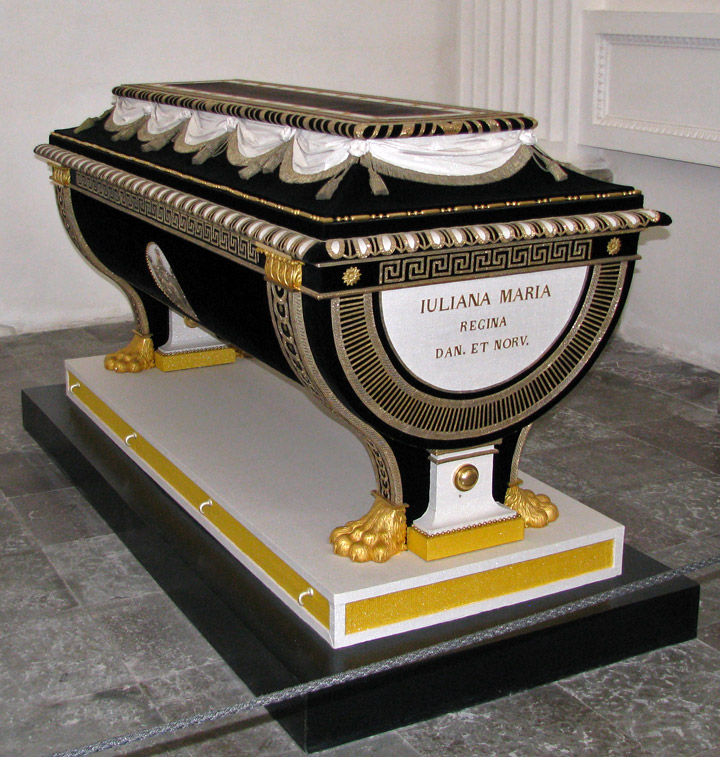
Juliana Maria of Brunswick,
(1729–1796), (always called Juliane Marie), was queen of Denmark between 1752
and 1766
, second consort of king Frederick V of Denmark and Norway, mother of the
prince-regent Hereditary Prince Frederick of Denmark and Norway and herself de
facto regent 1772–1784.
Born as daughter of Ferdinand Albert II, Duke of Brunswick-Wolfenbüttel and
Antoinette of Brunswick-Wolfenbüttel, she became the second consort and queen to
king Frederick V of Denmark in 1752, one year after the death of his first
consort Louise of Great Britain.
As a queen, she lived a quiet life. She became more important as a dowager
queen. In 1766, she became a widow. In 1768, she participated in the banishment
of Christian's mistress Støvlete-Cathrine, who was believed to have influence
over him. In 1770, the new king, her stepson king Christian VII of Denmark, had
become insane and the power had fallen in the hands of his consort Caroline
Matilda of Wales and her lover Johann Friedrich Struensee. They had a liberal
politics and issued a row of democratic laws that raised the opposition to the
nobility. Juliane Marie then became the centre of the opposition, and she was
one of the group that participated in the coup d'etat that brought down the
government of Struensee by exposing his affair with the queen. In 1772,
Struensee was executed and queen Caroline Mathilda was exiled.
The son of Juliane Marie, Hereditary Prince Frederick, was now made regent. In
reality, he was the puppet of his mother, who was the real and undisputed ruler
during his regency. Her government was one of extreme conservatism. She saved
the privileges of the nobility and was regarded as the hero of the aristocracy
and the saviour of their privileges.
In 1784, she and her son were deprived of their regency by the crown prince,
King Frederick VI of Denmark
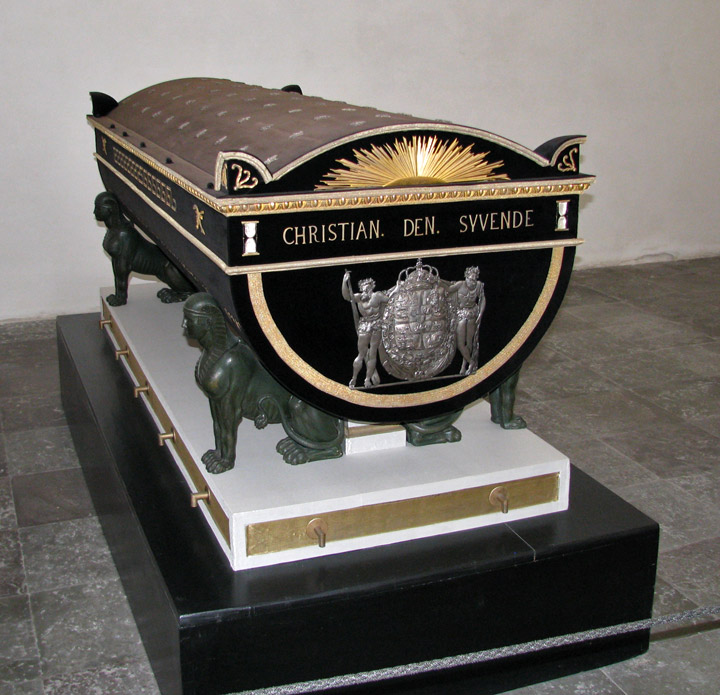
Christian VII (January 29, 1749 - March 13, 1808) was King of Denmark and Norway, and Duke of Schleswig and Holstein from 1766 until his death.h.
He was the son of Frederick V,
King of Denmark, and his first consort Louisa, daughter of George II of Great
Britain.
He became king on his father’s death on January 14, 1766. All the earlier
accounts agree that he had a winning personality and considerable talent, but he
was badly educated, systematically terrorized by a brutal governor, Detlev
Reventlow, and hopelessly debauched by corrupt pages, and while he seems to have
been intelligent and certainly had periods of clarity, Christian suffered from
severe mental problems, possibly schizophrenia.
After his marriage in 1766 to his cousin Princess Caroline Matilda (known in
Denmark as Queen Caroline Mathilde), a sister of King George III of Great
Britain, he abandoned himself to the worst excesses, especially debauchery. In
1767, he entered in to a relationship with the courtisan Støvlet-Cathrine. He
publicly declared that he could not love Caroline Mathilde, because it was
"unfashionable to love one's wife". He ultimately sank into a condition of
mental stupor. Symptoms during this time included paranoia, self-mutilation and
hallucinations. He became submissive to upstart Johann Friedrich Struensee, who
rose steadily in power in the late 1760s. The neglected and lonely Caroline
Mathilde drifted into an affair with Struensee.
In 1772, the king’s marriage with Caroline Mathilde was dissolved. Struensee was
arrested and executed in that same year. Christian signed Struensee's arrest
warrant with indifference, and under pressure from his stepmother, Juliana Maria
of Brunswick-Wolfenbüttel, who had led the movement to have the marriage
dissolved. Caroline Mathilde, retaining her title but not her children,
eventually left Denmark in exile and passed her remaining days in neighbouring
Celle. She died of scarlet fever there on May 11, 1775.
The marriage had produced two children, the future Frederick VI and Princess
Louise Augusta. However, it is widely believed that Louise was the daughter of
Struensee - portrait comparisons have supported this.
Christian was only nominally king from 1772 onwards. From 1772 to 1784, Denmark
was ruled by Christian's stepmother Juliana Maria of Brunswick-Wolfenbüttel, his
physically disabled half-brother Frederick and the Danish politician Ove
Høegh-Guldberg. From 1784 onwards, his son Frederick VI ruled permanently as a
prince regent. This regency was marked by liberal and agricultural reforms but
also by the beginning disasters of the Napoleonic Wars.
Christian died in 1808 at Rendsburg, Schleswig, not of fright as some have
suggested, but from a brain aneurysm. He was 59.
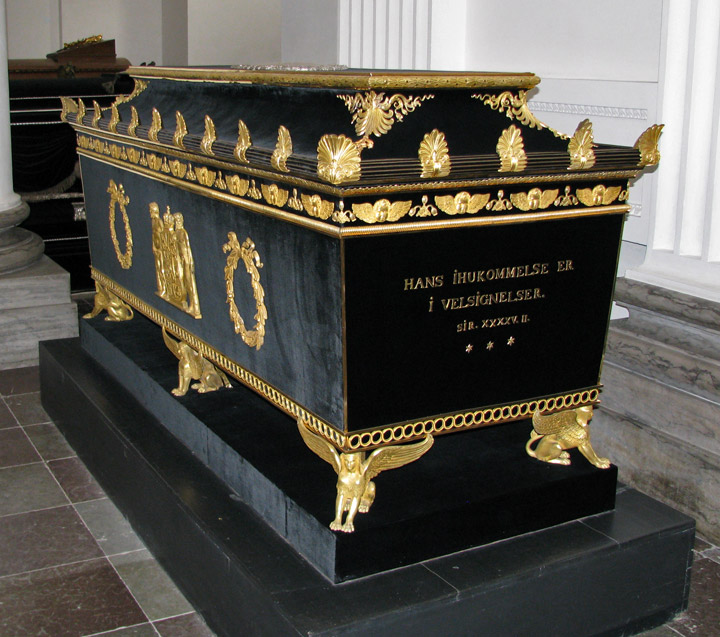
Frederick VI (January 28, 1768 -
December 3, 1839) reigned as King of Denmark from 1808 to 1839
and as king of Norway from 1808 to 1814.
He also served as Regent of Denmark
from 1784 to 1808 under his father's name, just like his British cousin The
Prince of Wales, later King George IV. His mother, Queen Caroline Mathilde, was
a sister of King George III of the United Kingdom. His father, Christian VII,
had major psychological problems, including suspected schizophrenia, expressed
by catatonic periods, that resulted in his standing down from power for most of
his reign.
During the regency, Frederick instituted widespread liberal reforms with the
assistance of Chief Minister Andreas Peter Bernstorff, including the abolition
of serfdom in 1788. Crises encountered during his reign include disagreement
with the British over neutral shipping. This resulted in two British attacks on
Danish shipping in 1801 and 1807. The former attack is known as the Battle of
Copenhagen.
His wife was his first cousin Marie Sophie of Hesse-Kassel (or Hesse-Cassel), a
member of a German family with close marriage links with the Royal families of
both Denmark and Great Britain. They married in 1790 and had eight children. The
youngest of them, Princess Wilhelmine, became the wife of the future Frederick
VII of Denmark. However, none of Frederick VI's sons survived infancy and when
he died, he was succeeded by his cousin, Christian VIII of Denmark.
When the throne of Sweden showed signs of becoming unoccupied in 1809, Frederick
was interested in becoming elected there, too. Frederick actually was the first
monarch of Denmark and Norway to descend from Gustav I of Sweden who had secured
Sweden's independence after union period with other Scandinavian countries.
(Also Frederick's sister was such descendant, both through their mother and her
mother. As well as Hereditary Prince Frederick of Denmark, their uncle, who
descended through Queen Juliane.) However, firstly Frederick's brother-in-law
the prince Augustus of Augustenborg got elected, then the French Marshal
Bernadotte.
After his defeat in the Napoleonic Wars in 1814 and the loss of Norway,
Frederick VI carried through an authoritatarian and reactionary course, giving
up the liberal ideas of his years as a prince regent. Censorship and suppression
of all opposition together with bad economic terms of the country made this
period of his reign somewhat gloomy, though the king himself in general
maintained his position of a "patriarch" and a well-meaning autocrat. From the
1830s the economic depression was eased a bit and from 1834 the king reluctantly
accepted a small democratic innovation by the creation of the Assemblies of the
Estate (purely consultative regional assemblies).
The surviving children of King Frederick VI and Queen Marie Sophie Frederikke
were their two daughters:
* Caroline of Denmark (1793-1881), married to her father's first cousin
Frederick Ferdinand of Denmark, d. 1863 some months before his nephew Frederick
VII of Denmark, Hereditary Prince of Denmark, son of Christian VIII of Denmark.
Childless.
* Wilhelmine of Denmark (1808-1891), firstly married to her second cousin Prince
Frederik of Denmark, the future Frederick VII of Denmark, but they divorced, and
she married secondly Duke Charles of Lyksborg (=Duke of Glucksburg), who was
eldest brother of the future Christian IX of Denmark. Both her marriages were
childless.
Frederick VI was known as a patron of astronomy and in 1832 offered gold medal
prizes to anyone who discovered a comet using a telescope. His successors
continued this until 1850. The prize was terminated in the aftermath of the
First War of Schleswig.
After discovery of Haraldskær Woman in a peat bog in Jutland in the year 1835,
Frederick VI ordered a royal interment in an elaborately carved sarcophagus for
the Iron Age mummy, decreeing it to be the body of Queen Gunhild. Later this
identity proved incorrect, but the action suited his political agenda of the
time.

Marie Sophie Frederikke (German: Marie Sophie Friederike von Hessen-Kassel; 28 October 1767 – 22 March 1852) was Queen Consort of Denmark and Norway.
She was the eldest child of Prince Charles of Hesse-Kassel (or Hesse-Cassel) and
Luise, Princess of Denmark and Norway. Her paternal grandparents were Frederick
II of Hesse-Kassel and Princess Mary of Great Britain. Mary was a daughter of
King George II and Caroline of Ansbach. Her maternal grandparents were Frederick
V of Denmark and Louise, another daughter of George II of Great Britain and
Caroline of Ansbach. Her father was the second son of the Landgrave, the
sovereign prince of Hesse-Kassel, and as such, had no principality of his own.
Thus he acted in such positions as were offered to cadet members of royal houses
by their reigning relatives. Denmark was offering more and better positions than
the small Hesse-Kassel.
She grew up largely in Denmark, where her father held notable positions, such as
the governorship of provinces. Her mother was the third and youngest daughter of
King Frederick V of Denmark and his consort, Louise of Great Britain. As such,
she was the niece of King Christian VII and of Prince Regent Frederik, as well
as the first cousin of Regent and Crown Prince Frederik, the Danish rulers of
that period.
On 31 July 1790 she married her first cousin, Crown Prince Frederik of Denmark
(1768-1839), then Regent of the Realm, the future King Frederick VI of Denmark.
Her husband had been since 1784 (when he was just 16 years old) the Regent on
behalf of his insane father Christian VII of Denmark, who would die in 1808. The
Royal couple assumed the throne officially only upon King Christian's death,
having acted as de facto monarchs already for over two decades. In the aftermath
of the defeat of Denmark's ally, Emperor Napoleon I of the French, Denmark lost
its dominion Norway; the Royal couple ceased to be Norway's King and Queen in
1814. Queen Marie was Regent of Denmark in 1814-1815 during her husband's
absence abroad.
They had eight children. However, none of Frederick VI's sons survived infancy
and when he died in 1839, he was succeeded by his cousin, Christian VIII of
Denmark. The surviving children of King Frederick VI and Queen Marie Sophie
Frederikke were their two daughters:
* Caroline of Denmark (1793-1881), married her father's first cousin, Hereditary
Prince Frederick Ferdinand of Denmark (died 1863), some months before his nephew
Frederick VII of Denmark, Hereditary Prince of Denmark, youngest son of
Frederick, Hereditary Prince of Denmark and Norway (and sometime regent) and as
such brother of Christian VIII of Denmark. She had no children
* Wilhelmine of Denmark (1808-1891), first married her second cousin Prince
Frederik of Denmark, the future Frederick VII of Denmark, but they divorced; and
she married second Karl, Duke of Schleswig-Holstein-Sonderburg-Glücksburg,
eldest brother of the future Christian IX of Denmark. Both her marriages were
childless.
Queen Marie Sophie Frederikke lamented the total lack of sons and of
grandchildren of her own. When her youngest sister, Duchess Louise Caroline of
Lyksborg became widow when most of her large brood of children were as yet very
young, Queen Marie accepted some of the younger ones into her tutelage in the
Royal Household. They were much younger than the Queen's own two surviving
daughters, and one may speculate that the Queen felt like a grandmother. One
such foster child of hers was Prince Christian of Lyksborg, born 1818, the
future Christian IX of Denmark.
Christian of Lyksborg and his wife Louise of Hesse named their second daughter,
Marie Sophie Frederikke Dagmar of Lyksborg (born 1847), in the Queen's honor as
her namesake. After her death (1852), that girl became Tsarina Maria Fedorovna
of Russia, preserving there the Queen's first name (Maria/Marie).
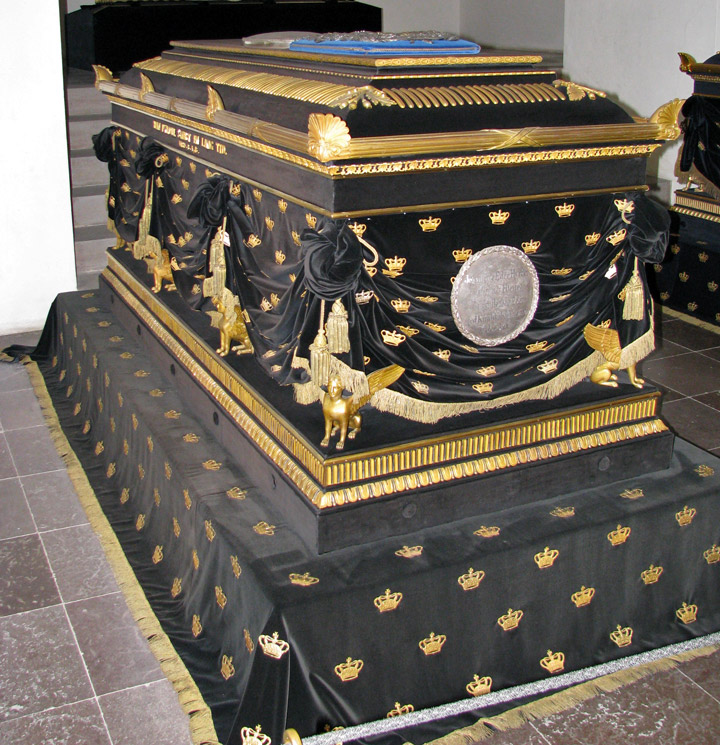
Christian VIII (September 18, 1786–January 20, 1848), king of Denmark 1839-48 and, as Christian Frederick, of Norway 1814, the eldest son of the Hereditary Prince Frederick of Denmark and Norway and Sophia Frederica of Mecklenburg-Schwerin, was born in 1786 at Christiansborg Palace in Copenhagen.
His paternal grandparents were the
late king Frederick V of Denmark and his second wife Juliana Maria of Brunswick-Wolfenbüttel.
He inherited the talents of his highly gifted mother, and his amiability and
handsome features are said to have made him very popular in Copenhagen. His
unfortunate first marriage with his cousin Charlotte Frederica of
Mecklenburg-Schwerin was dissolved in 1810. She was a daughter of Friedrich
Franz I, Grand Duke of Mecklenburg-Schwerin and Luise, Duchess of Saxe-Gotha.
His only son from this marriage would become Frederick VII of Denmark.
In May 1813, being the then heir presumptive of Denmark-Norway, he was sent as
stattholder (the Danish King's highest representative in overseas territories)
to Norway to promote the loyalty of the Norwegians to the dynasty, which had
been very rudely shaken by the disastrous results of Frederick VI's adhesion to
the falling fortunes of Napoleon I of France. He did all he could personally to
strengthen the bonds between the Norwegians and the royal house of Denmark.
Though his endeavours were opposed by the so-called Swedish party, which desired
a dynastic union with Sweden, he placed himself at the head of the Norwegian
party of independence after the Treaty of Kiel had forced the king to cede
Norway to the king of Sweden. He was elected Regent of Norway by an assembly of
notables on February 16, 1814.
This election was confirmed by a constitutional assembly convoked at Eidsvoll on
April 10, and on May 17 the constitution was signed and Christian was
unanimously elected king of Norway, under the name Christian Frederick.
Christian next attempted to interest the great powers in Norway's cause, but
without success. On being pressed by the commissioners of the allied powers to
bring about a union between Norway and Sweden in accordance with the terms of
the treaty of Kiel, and then return to Denmark, he replied that, as a
constitutional king, he could do nothing without the consent of the parliament (Storting),
which would not be convoked until a suspension of hostilities on the part of
Sweden.
Sweden refusing Christian's conditions, a short campaign ensued, in which the
Norwegian army was defeated by the forces of the Swedish crown prince Charles
John. The brief war was finally concluded by the Convention of Moss on August
14, 1814. According to this treaty, king Christian Frederick transferred the
executive power to the Storting, and then abdicated and returned to Denmark. The
Storting in its turn adopted the constitutional amendments necessary to allow
for a personal union with Sweden, and on November 4 elected Charles XIII of
Sweden as the new king of Norway.
Henceforth Christian's suspected democratic principles made him persona
ingratissima at all the reactionary European courts, his own court included. He
and his second wife, Caroline Amalia of Augustenburg (daughter of Louise Augusta
of Denmark, only sister of Frederick VI), whom he married in 1815, lived in
comparative retirement as leaders of the literary and scientific society of
Copenhagen.
It was not until 1831 that old King Frederick gave him a seat in the council of
state. On December 13, 1839 he ascended the Danish throne as Christian VIII. The
Liberal party had high hopes of “the giver of constitutions,” but he
disappointed his admirers by steadily rejecting every Liberal project.
Administrative reform was the only reform he would promise. In his attitude to
the growing national unrest in the twin-duchies he often seemed hesitating and
half-hearted which damaged his position, and not until 1846 did he clearly
support the idea of Schleswig being a Danish area.
Some historians and biographers believe, however, that king Christian would have
given Denmark a free constitution had he lived long enough, and his last words
are sometimes (rather tragically) recorded as "I didn't make it".
King Christian VIII continued his predecessor's patronage of astronomy, awarding
gold medals for the discovery of comets by telescope, and financially supporting
Heinrich Christian Schumacher with his publication of the scientific journal
Astronomische Nachrichten.
Seeing that his only son, the future Frederick VII, was apparently unable to
beget heirs, he commenced arrangements to secure the succession in Denmark,
which led to the future Christian IX being chosen as a hereditary prince,
officially by a new law enacted on 31 July 1853, after an international treaty
made in London.
He died of blood-poisoning in 1848 and was interred in Roskilde Cathedral.

Caroline Amalie
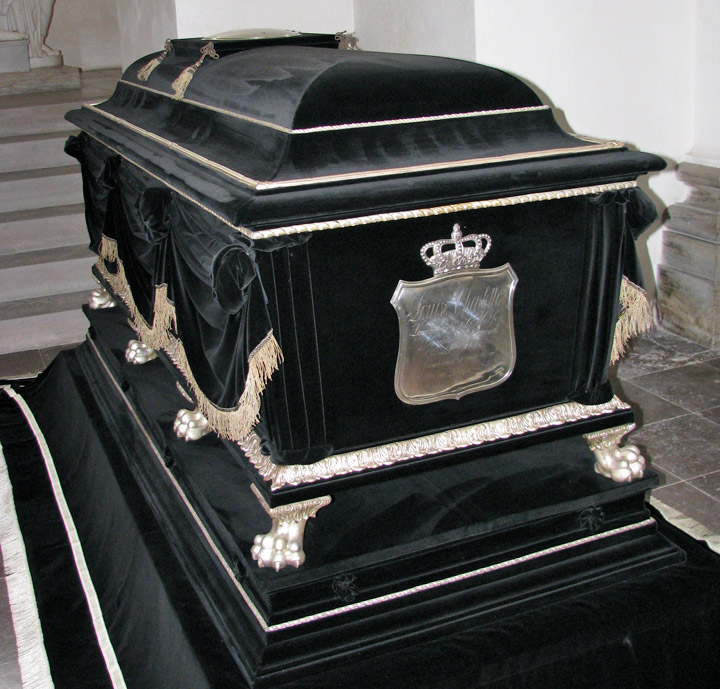
Louise of Mecklenburg-Güstrow (28 August 1667 – 15 March 1721) was Queen consort of Denmark and Norway as the first wife of the King Frederick IV of Denmark.
She was born in Güstrow in the family
of Duke Gustav Adolf of Mecklenburg-Güstrow and Magdalene Sibylle of Holstein-Gottorp.
Her maternal grandparents were Frederick III of Holstein-Gottorp and Marie
Elisabeth of Saxony.
On 5 December 1695, Louise married to Crown Prince Frederik and became Queen
consort of Denmark in 1699. Their only child who reached maturity was King
Christian VI of Denmark.
Louise lived quietly at the Danish Court. Unlike Frederick IV she never gained
popularity with the population. Queen Louise suffered because of her husband's
infidelity, which caused embarrassing scenes at the Court. Frederick even
entered two morganatic marriages. He raised one of his mistresses, Anna Sophie
Reventlow, to the status of Queen just days after Louise's death. Queen Louise
was close to her son Christian. She was strongly influenced by Pietism and she
sought solace in religion.
Rosenborg was completely abandoned as a Royal residence while Louise was Queen.
The building of a new summer residence, Frederiksborg Palace, began in 1699 and
was ready for occupation in 1703.
She died in Copenhagen and was buried in the Roskilde Cathedral.
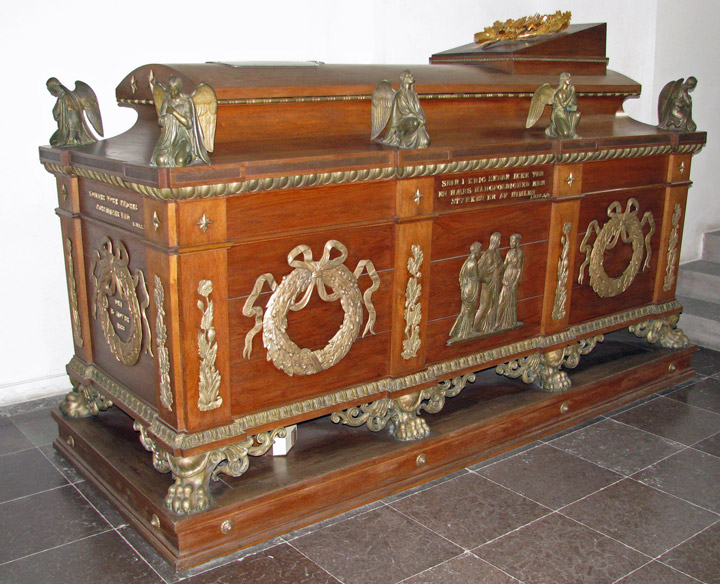
Frederick VII (October 6, 1808 - November 15, 1863) was King of Denmark. He reigned from 1848 until his death.
He was the last Danish monarch of the
older royal branch of the House of Oldenburg, and also the last king of Denmark
to rule as an absolute monarch. During his rule, he signed a constitution that
gave Denmark a parliament and made the country a constitutional monarchy.
Frederick VII managed to make himself one of the most beloved of the Danish
kings of recent times. This was probably due to his giving up absolutism but
also to his personality. In spite of many weaknesses confirmed by his
contemporaries — mythomania, drinking, eccentric behavior, etc. — he also
possessed something of a gift as an actor. He could be both folksy and genuinely
hearty, being able to appear as a ”simple, yet dignified monarch”. During his
many travels throughout Denmark he cultivated his contacts with the common man.
His motto was: The people's love, my strength.
Frederick was born at Amalienborg Palace to Christian VIII of Denmark and
Charlotte of Mecklenburg-Schwerin. His maternal grandparents were Friedrich
Franz I, Grand Duke of Mecklenburg-Schwerin and Luise, Duchess of Saxe-Gotha.
The king's first two marriages both ended in scandals and divorces. He was first
married 1828-1834 to his second cousin, Princess Vilhelmine Marie of Denmark, a
daughter of Frederick VI; and then 1841-1846 to Caroline Charlotte Mariane of
Mecklenburg-Strelitz.
In 1850 he morganatically remarried to Louise Rasmussen (in Denmark famous as
Countess Danner), a common milliner and former ballet dancer who had for many
years been his acquaintance or mistress. This marriage seems to have been happy
although it aroused great social indignation among the nobility and the
bourgeoisie. Countess Danner, who was denounced a vulgar gold-digger by her
enemies, but a doughty and unaffected “daughter of the people” by her admirers,
seems to have had a stabilizing effect on him. She also worked at maintaining
his popularity by letting him “meet the people” of the provinces.
The expectation that Frederick would not likely produce an offspring, despite
numerous affairs, was wide-spread, but sources rarely state the reasons. Some
speculate that Frederick was merely sterile. Already during the reign of
Frederick's father, King Christian VIII, the succession question was brought
forward. (See below: Succession crisis)
It has been claimed Frederick had a same-sex relation to his friend Carl Berling,
printer and owner of the newspaper Berlingske Tidende. The bisexual Berling had
an illegitime child with Louise Rasmussen, Carl Christian, who was much liked by
the King, to the extent that he insisted to sign the new constitution on Carl
Christian's 8th birthday on 5th June 1849. To retain a tinge of decency, the
King married Louise Rasmussen and the trio then moved into the royal castle
where Berling was appointed Chamberlain and remained till 1861. The public
indignation within higher circles over Frederick's morganatic marriage is
well-known, but reasons have rarely been explained in detail.
Frederick who was the last king of the older branch of the Oldenburg dynasty had
a rather neglected childhood after the divorce of his parents. His youth was
marked by private scandals and for many years he appeared as the ”problem child”
of the royal family.
When he succeeded to the throne January 1848 he was almost at once met by the
demand for a constitution. Besides the Schleswig-Holsteiners wanted an
independent state while the Danes wished to maintain South Jutland as a Danish
area. The king soon yielded to the Danish demands, and in March he accepted the
end of absolutism, which resulted in the first June Constitution of 1849. During
the First War of Schleswig against the German powers in 1848-51 Frederick
appeared as ”the national leader” and was regarded almost as a war hero despite
having never taken any active part in the struggles.
During his reign Frederick as a whole behaved as a constitutional monarch.
However he did not quite give up interfering in politics. In 1854 contributed to
the fall of the strongly conservative Ørsted Cabinet and 1859-60 he accepted a
liberal government which was appointed on the initiative of his wife. During the
crisis in the Duchies 1862-63 shortly before his death he also openly spoke for
an inter-Scandinavian military co-operation. Those minor crises created
frictions and maintained some permanent insecurity but it did not damage his
general popularity. In some of these affairs he overstepped the mark beyond any
doubt; on the other hand the first Danish constitution was somewhat vague as
regards to the limits of royal power.
The rule of Frederick was also the golden age of the National Liberal Party
which was in office from 1854. This period was marked by some political and
economic reforms, such as beginning the demolition of the walls around
Copenhagen and the introduction of free trade in 1857. The constant quarrels
with the opposition regarding the Schleswig-Holstein Question and the German
demands of not trying to unite Denmark with Schleswig (South Jutland) led to
some changes to the constitution in order to fit the foreign political situation
which created frustration in Denmark. The National Liberals therefore at last
favored a more resistant course against the Germans which led to the Second War
of Schleswig in 1864. The king wholeheartedly supported this course and just
before his sudden death he was prepared to sign a new special constitution for
Denmark and Schleswig (the so-called November Constitution).
Frederick was married three times, and had numerous affairs to boot, but
produced no issue. The fact that he reached middle age without producing an heir
meant that Prince Christian of Glücksburg (1818-1906), the descendant of a
cousin of King Frederick VI, was chosen to succeed him in 1852. When Frederick
died in 1863, Christian took the throne as Christian IX.
Because of Salic law, the succession after childless Frederick was a difficult
question to arrange, and it did not go smoothly, but caused a war. Nationalism
in the German-speaking parts of Schleswig-Holstein meant that no solution to
keep the Duchies united with Denmark was satisfactory. The duchies were
inherited according to the salic law among descendants of Helwig of Schauenburg,
the senior of which after Frederick himself was Frederick, Duke of Augustenburg
(who proclaimed himself Duke of Schleswig-Holstein after Frederick VII's death).
This Friedrich von Augustenburg had become the symbol of the nationalist German
independence movement in Schleswig-Holstein, since the time that his father in
exchange for money had renounced his claims as first in line to inherit the twin
duchies of Schleswig and Holstein, following the London Protocol of May 8, 1852,
which concluded the First War of Schleswig. Because of his father's
renunciation, Frederick was regarded as ineligible to succeed.
Denmark was also under Salic law, but only among descendants of Frederick III
(who was the first hereditary monarch of Denmark, since before him the kingdom
had been officially elective). Agnatic descendance of Frederick III went extinct
when Frederick VII died, and at that point, the succession law promulgated by
Frederick III provided a "semi-Salic" succession. There were however several
alternative ways to interpret the line of succession, because the provision was
not entirely clear on whether it be the closest female relative or what to
inherit. The question was solved by an election and a separate law to confirm
the new successor.
The closest female relatives of Frederick VII were the issue of his paternal
aunt, Louise, who had married a cadet Landgrave of Hesse. However, they were not
agnatic descendants of royal family and thus not eligible to succeed in
Schleswig-Holstein. The dynastic female heiress according to the original
primogeniture from Frederick III was the childless daughter of late king
Frederick VI, after whom the original primogeniture would have led to heirs of
Louise, sister of Frederick VI, who had married the then duke of Augustenburg.
The chief heir to that line was the selfsame Frederick of Augustenburg, but his
turn would have come only after the death of a childless princess who was very
much alive in 1863.
Some rights belonged also to the line of Glücksburg, a more junior branch of the
royal clan. They were also heirs of Frederick III, through their one ancestress
who was daughter of King Frederick V of Denmark, and they were a more junior
agnatic heirs eligible to succeed in Schleswig- Holstein. There were Christian
of Glücksburg (1818-1906) and his two elder brothers, eldest of whom was
childless, but the second had produced children, also male children.
Prince Christian of Glücksburg (1818-1906) had been a foster "grandson" of the
sonless royal couple Frederick VI and Queen Marie Sophie, thus familiar with the
royal court and the traditions of the recent monarchs. Prince Christian was
great-nephew of Queen Marie Sophie, and descendant of a first cousin of
Frederick VI. He was brought up as Danish, having lived in Danish-speaking lands
of the royal dynasty, and was not attached to German nationalism. Although these
did not mean anything legally, they made him a relatively good candidate from
the Danish viewpoint. As junior agnatic descendant, he was eligible to inherit
Schleswig-Holstein, but not the first in line. As descendant of Frederick III,
he was eligible to succeed in Denmark, but not first in line, however that line
was not very clear.
Christian of Glücksburg (1818-1906) married then Princess Louise of Hesse,
eldest daughter of the eldest son of the closest female relative of Frederick
VII. Louise's father and brothers, princes of Hesse, renounced their rights in
favor of Louise and her husband. Prince Christian's wife was now the closest
female heiress of Frederick VII.
The thorny question of operation of semi-Salic provision in succession of
Denmark was at that point resolved by legislation through which Prince Christian
of Glücksburg (1818-1906) was chosen in 1852 to succeed the King Frederick VII
in Denmark.
Frederick VII died in 1863 and was interred in Roskilde Cathedral. Christian
took the throne as Christian IX.
In November 1863 Frederick of Augustenborg claimed the twin-duchies in
succession after King Frederick VII of Denmark, who also was the Duke of
Schleswig and Holstein, and who had died without a male heir.
Prussia and Austria started the Second War of Schleswig.
Text from Wikipedia